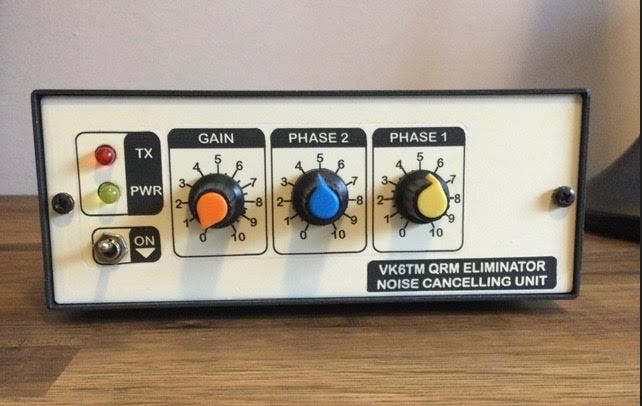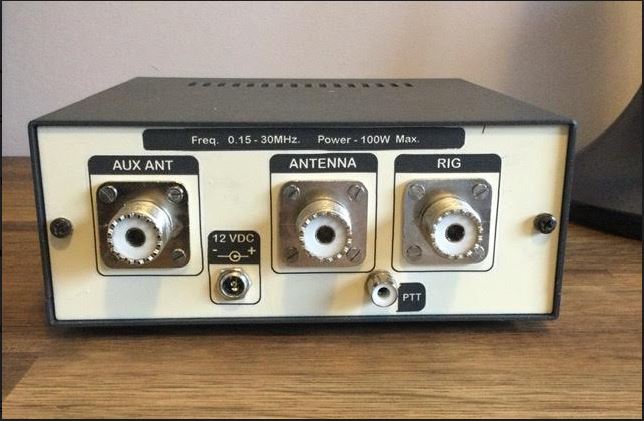A noise cancelling system based on nulling out local interference can be an effective method of improving reception on the hf bands. The noise cancelling system to be described here consists of the ‘Main Station Antenna’ receiving a wanted signal and associated QRM and a separate ‘Auxiliary Antenna’ designed only to pick up the unwanted interference. The operator uses a combination of gain and phasing controls to reduce / remove the interference leaving only the wanted signal. Fig. 1 & 2. show my homebrew noise canceller.


The following sections will focus on the role and importance of the ‘Auxiliary Antenna’ with the aim of enabling you to optimise your system with tips based on my own personal experience. The following text will apply equally to commercial noise cancelling products as well as those in kit form or homebrew. I hope you find it helpful.
But before we start, this short video shows what can be achieved when the auxiliary antenna is optimised. I recorded the following clip during my setup and shows how effective a noise cancelling system can be at eliminating interference and thus improving the readability of the wanted stations.
Let’s start
The design and configuration of the auxiliary antenna is the most critical element of the noise reduction system. There is no such thing as a one size fits all auxiliary antenna, it is determined by a number of factors specific to your situation but ideally should only pick up the unwanted interference. In reality this is difficult to achieve but taking your time to find the optimum arrangement will pay dividends and don’t expect to attach any odd length of wire and obtain good results, but you may be lucky.
The first step is to identify the source of the most severe interference. I noted the frequency and used a portable radio to locate the best position for the antenna. Depending on your circumstances, this may be within your house, at the boundary with a neighbour’s property or adjacent overhead power / telephone lines.
Optimising the auxiliary antenna
Having determined the best position install and connect your auxiliary antenna to the noise canceller. If the interference is within a few metres a short length of wire may be all you need, or if more remote I would recommend installing a coaxial cable to a wire antenna, remember the aim is to pick up the interference and as little as possible of the wanted signal . In my case the option that give the best results, was to use an unused spare core within my antenna rotator cable. Be prepared to experiment and trial different antenna configurations, locations and lengths to achieve the optimum result. Remember get this critical step right and the noise canceller will do the rest.
Setting and adjusting your noise canceller
Power up and switch on the noise canceller. Set gain and phase controls to ‘0’ (usually fully anti-clockwise) Tune to the interference received by the auxiliary antenna and note the signal strength. This is best observed on a spectrum / waterfall display, but can be achieved by noting your s- meter reading. Now adjust the gain control(s) such that the unwanted interference received by the main station antenna is equal in amplitude to that of the auxiliary antenna. If you are using your s-meter, advance the gain control to a point where you observe a slight increase in signal strength. Now adjust in turn the two phase controls to reduce / null out the interference, this point may well be quiet critical so be prepared to readjust and tweak the gain and phase controls to achieve the best result.
Final thoughts and observations
I am quite please with my noise canceller and it has enabled me once again to enjoy listening and working on the 80m and 40m bands. There are however a few points that I think are worth noting.
Signals heard on your receiver are the sum of signals pickup on the main station antenna and the auxiliary antenna, the process of nulling out interference is achieved by inverting the interference picked up by the auxiliary antenna thus leaving only the wanted signal. For instance, I found that one source of interference picked up by the auxiliary antenna was inaudible on the main station antenna. No amount of adjustment will remove the QRM, In this case the only course of action is to disable the auxiliary antenna by switching off the noise canceller.
My auxiliary antenna is poor at receiving stations, but there are occasions when a ham station is particularly strong and nulling the interference results in a marked attenuation of the wanted station’s readability.
In general, when nulling out interference expect to experience a slight reduction in the wanted station’s signal strength, this is entirely normal.
I hope you have found this article useful and if you have any questions or suggestions please don’t hesitate to get in touch. dc.g0bcu@gmail.com




